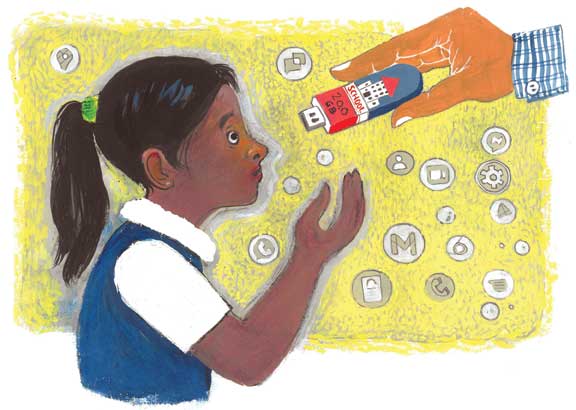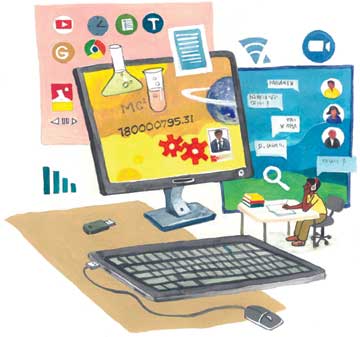Shruti Singhal
As I write this piece, the High Court of Telangana stayed the state government’s order to reopen schools to mixed responses. At the same time, the rule made it clear that it is not mandatory for students to attend school, nor can they be penalized for choosing to study from home. This aspect of choice, exercised by the student and/or their parents, will go on to be a defining factor of education in India in the next few years.
From your friendly neighborhood teacher to one on your mobile device
In the 90s and 2000s, you went to a tuition teacher after school, most likely in your neighborhood, for the subject(s) that you were weak in. These mostly ended up being math and the sciences – physics and chemistry. A few years later, organizations sprung up that sent the tutor to your home, saving your time and energy. If you had plans to pursue MBBS/IIT-JEE, you sought training institutes and enrolled there. These institutes used projectors, (fancy equipment for the time) and lured students with laptops or tablets as part of the ‘package’.
When international schools started gaining popularity and offered all this and more, private schools did not want to be left behind. They installed projector systems and introduced computer classes to enable audio-visual elements in teaching and learning.
But, by then, a new breed of learning avenues had arrived.
“As online versions of offline counterparts, edtech companies like Unacademy and Byju’s, that started from 2012, brought in the first wave of edtech in India,” says Taran Singh.
Founder of an edtech startup, Melvano, Taran Singh talks to me at length about the rate of technology adoption in Indian schools. And I remember what he’s referring to – PowerPoint presentations replaced the blackboard and chalk pieces, handwritten notes discarded in favor of pdf notes and lectures sold on CDs and pen drives. My own school adopted some of these ‘tech’ elements that my contemporaries used and benefited from.
But it wasn’t all slide shows and electronic gadgets.
By 2017, the second wave of edtech had arrived, fueled by greater internet penetration. It was much easier to create, share, and consume educational content online through videos on apps and websites, especially for the early adopters in tier-1 cities. Taran Singh says, “From 2 GB of data a month to 2 GB a day, the accessibility and affordability of mobile data due to Reliance Jio was a game changer.”
What started with schools installing systems to enable audio-visual elements in learning, saw a gamut of software, tools, and technologies that seek to meet the specific needs of each child. Artificial Intelligence (AI) and Machine Learning (ML) are being explored in platforms where the student is no longer the passive recipient in the teaching process, but an active participant in the learning loop. According to Singh, we are now in the late second stage of edtech, where products are reaching tier-2 and tier-3 cities.
“During the early days of the pandemic, people were reluctant with online education, but it has now become the default mode of learning, and this is a huge upside of the demand,” shares Satish Manchala, an entrepreneur in the edtech space in Hyderabad.

But what led to this demand in the first place?
Minu Salooja answers, “Education and automation collectively and independently are two sectors that are going to expand extensively, since they are not just the need of the hour but have always been an indispensable need. What might change or evolve is the extent of automation.” She is Assistant Director, Glendale Group of Schools, Hyderabad.
I wonder if it’s something more fundamental about the Indian education system that’s contributing to this tech-enabled disruption. The skewed student-to-teacher ratio, for instance. For another, Kaveri Jain, a parent, highlights that the school curriculum has not been considerably revised with the current times.
“Edtech apps and services also provide more practice material and better ways of explaining concepts,” shares Samarjeet. He’s 13 and has been using Cuemath for the last three years.
Another student, Utsav Khodiar, says, “We can’t always get our doubts cleared in class, and since edtech apps focus on conceptual clarity, they help with semi-practical knowledge and make studies fun. Also, before subscribing to an edtech app, I struggled with several concepts because of the traditional rote education method. At the same time, the apps don’t give us the textbook knowledge, whether terminologies or keywords, which is a must for clearing the CBSE or any Indian board exam.”
Preparedness for the “real” world is an oft-cited selling point for such services – whether appearing for an exam or landing a job. But are schools and edtech companies missing something vital?
N S Ranjan shares, “Until class 10, my focus was on scoring good marks by writing long answers, which majorly led to rote-learning. But when I moved to class 11, the entire narrative of learning changed, and all that mattered was having a strong understanding of the concepts.”
And so, on completing his education, he started Concept Kendra, “to ensure conceptual understanding among students from an early age, where they have the genuine interest to learn the subject and improve their skills, while prioritizing their mental health.”
Edtech: Extension or replacement?
The possibilities for constant learning and improvement make a strong case in favor of edtech. Startups build platforms that can adapt to the specific needs of a child and track how much time they spent on a subject and where they got stuck, and cloud offerings for self-directed and personalized learning experiences that go beyond the scope of a traditional learning management system. All this is crucial information that helps the developer, and therefore the teacher, better understand where the student is lacking. This information contributes to greater understanding of learning perspectives.
Secondly, with the rise in digital platforms, students have the choice to access high-quality educational content from anywhere. And if students can access education from anywhere, teachers too must remember to broaden the scope of their subjects and their teaching methods. They must become enablers of the lesson, adapting content from different sources and aim at holistic learning of a topic.
Satish Manchala says, “The current scenario of online learning is like watching TV, where the teacher comes on the screen, reads out their script and leaves when it is done; there is no space for interaction between the teacher and the student. Kids lose track of what is being taught and find it hard to get clarifications in the one-way traffic or to get responses from the chat. And the moment students don’t learn, they lose interest.” His platform, Tuturoot, incorporates adaptive and interactive tools to combat these issues.
Despite the normalization of e-learning and online classes since the outbreak of COVID-19, the very nature of the education system could also undergo a change.
Some, like Taran Singh and N S Ranjan, feel that edtech may replace schools. Taran says, “People will do away with schools as they exist right now; people are realizing that their kids are going to school but not learning what they want, and the return on investment is low. Sooner or later, people will realize that education is not worth all the money and the years they spend on it; more kids will be homeschooled.”
It seems like an undeveloped plot point from a science fiction novel in progress, but it is not entirely implausible. Because as much as children have lost in terms of social and interpersonal skills while studying from home during the pandemic, it is worth noting that the traditional school system was not always a space conducive to mental health concerns.

Ranjan explains, “Everyone who finished their schooling will tell you that the best thing about that time is their friends, games, and everything else apart from learning. Students enjoy learning but not the way it is done at schools with all the competition and other negative factors that affect their minds during and beyond their school years.”
He tells me that he imagines an educational structure that advocates individualism, where students “do all their learning online for 3-4 hours a day and spend the rest of the time doing what they individually love – playing a sport, learning an art like music or writing, or pursuing anything else that interests them. But whatever the medium of instruction, imparting a balanced form of education is utmost important.”
The Venn diagram
Just as corporate organizations are experimenting with fully-remote or hybrid arrangements, it’s likely that schools will come up with their own versions of phygital (physical + digital) classrooms.
Minu Salooja says, “AI can potentially even replace teachers in the future with the usage of holograms and virtual reality. While this is a gateway to new possibilities and perhaps a more stimulating learning experience, it eliminates the century-old direct human contact essential for learning and development.”
She adds, “Learning is a constant process and therefore there is no end to it. Teachers need to acknowledge that despite their rich experience, with changing times, one has to evolve as well. This can be achieved by attending teacher development courses and sessions. Address the issue of changing needs and behaviors of students, then deliberate and implement ideas within the teaching community. The opinions of students might also help in achieving a better understanding of their problems and making the learning experience more personalized. They also should keep themselves recharged in the social and emotional aspect.”
Manija Subramanyam, Principal, Rockwell International School, Hyderabad, offers a balanced view. She tells me, “Edtech should not be considered as a competitor, but an integral part of education, and teachers need to blend it in their own learning/teaching practice. Teachers should upskill with a variety of tech tools to keep up pace. Students, in general, are exposed to different tools on one device or another. In this sense, the pedagogy of teaching is not the only aspect that should undergo change but the assessment style should be learnt to implement. Most of the time, teaching is targeted towards the assessment which needs to be revisited.”
Technology and data sciences offer optimistic prophecies for the future and a wide spectrum of options. These advancements also reveal the gaps in our proposed solutions – of access, privilege, and power. In our haste to solve the dilemmas presented by the pandemic, we must pause to ask ourselves – what are we gaining as a species, and what are our children losing?
The author is a content specialist based in Hyderabad, India. She can be reached at shrutisinghal.ss@gmail.com.
Related Article
